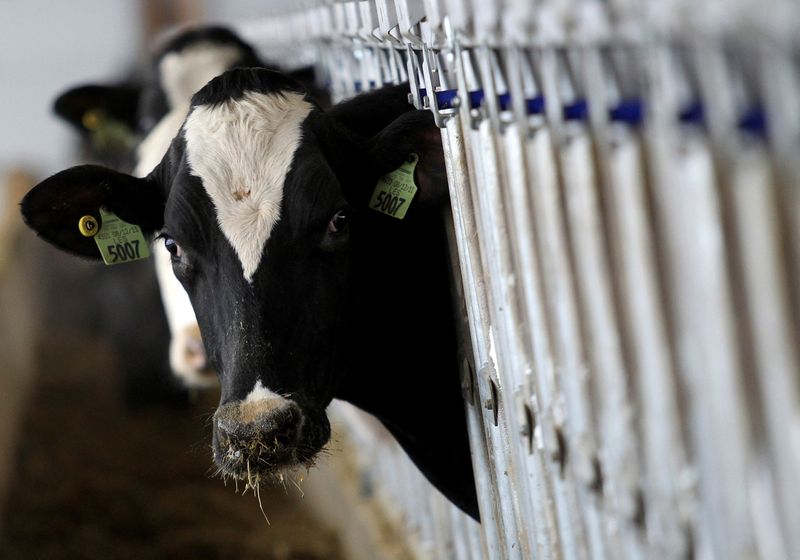By Julie Steenhuysen
CHICAGO (Reuters) -A second human case of bird flu was confirmed in a dairy worker in Michigan, U.S. government officials said, expanding the impact of the H5N1 outbreak, which has been found in dairy cattle in nine states.
The case follows the infection of a Texas farm worker and health officials said the risk to people remains low.
WHY IS H5N1 OR BIRD FLU A CONCERN?
The spread of bird flu among dairy cattle reflects an expansion of the range of mammals that can be sickened by the virus that typically infects birds.
Influenza experts said finding a second case of bird flu in humans was worrisome.
Scientists are on alert for changes in H5N1 that could signal the virus is adapting to spread easily among humans. The virus has caused serious or fatal infections among people in close contact with wild birds or poultry. It has long been on the list of viruses with pandemic potential, and any expansion to a new mammal species is concerning.
The infections in cattle are from the same subtype of bird flu that has been infecting wild birds and poultry flocks globally for more than two years, also killing several mammal species that likely contracted the virus from consuming sick or dead birds.
HOW WIDESPREAD IS THE BIRD FLU OUTBREAK IN CATTLE?
The full extent remains unknown, but several recent developments suggest it may be in more herds than documented.
On April 23, the U.S. Food and Drug Administration said it has detected fragments of the H5N1 virus in the milk supply. It said tests of 297 samples found the remnants of virus were inactivated by the pasteurization process, and that the milk is safe. U.S. health officials believe people cannot get sick from drinking pasteurized milk but warn not to drink raw unpasteurized milk.
Officials have learned the virus can be present in cows that show no signs of infection, and milk from those cows does not show signs of infection such as being thicker or yellow.
To contain the outbreak, the U.S. government is requiring dairy cattle moving between states to be tested for bird flu.
WHEN DID THIS BIRD FLU OUTBREAK START?
U.S. officials had thought the outbreak was recent, but new information suggests it may have started late last year.
A study funded by the U.S. Department of Agriculture and the CDC published this month found bird flu was likely circulating on a limited basis as far back as late 2023. The study said it believed wild birds transmitted the virus to cattle, which then expanded when the cows were shipped to other states.
HOW IS H5N1 SPREADING?
It remains unclear how the virus is spreading, but there is evidence of wild bird-to-cow, cow-to-cow, cow-to-poultry, and one case of cow-to-human transmission. There is no evidence of human-to-human transmission, officials reiterated.
Because of the heavy viral load in milk and mammary glands, scientists suspect the virus is being spread to animals during the milking process, either through contact with infected equipment or with virus that becomes aerosolized during cleaning procedures.
It remains unclear whether the virus can spread through respiratory droplets that infect the airway, as flu viruses typically spread in humans.
A nasal swab from the Michigan worker tested negative for influenza in a state lab. But an eye swab from the patient was shipped to CDC and tested positive for the H5N1 virus, the CDC said, indicating it may have been transmitted in that way.
IS THERE A BIRD FLU VACCINE FOR HUMANS?
The U.S. has a stockpile of bird flu vaccines matched with the strain currently circulating, as well as antivirals that could be used to treat human infections. For a major epidemic or a pandemic, the U.S. would have to scale up considerably.

Last week, the U.S. government started manufacturing approximately 4.8 million doses of vaccine matched to the currently circulating strain of H5N1, a U.S. official said.
Flu vaccine suppliers Sanofi (NASDAQ:SNY), GlaxoSmithKline (NYSE:GSK) and CSL (OTC:CSLLY) Seqirus have said they are monitoring avian flu and stand ready.